Chandrayaan 2, India’s first mission to attempt a Moon landing
The complexity and cost of a robotic lunar landing mission is enormous; only three countries have been successful so far.

Chandrayaan 2 is India’s first space mission of its kind. In this mission, the Indian Space Research Organization (ISRO) will attempt to soft-land a spacecraft on the Moon. If successful, India will go down in history as the fourth country to achieve a lunar landing, following the US, the USSR and China.
Getting there
When Chandrayaan 2 was approved in 2007, the lander—the colloquial name of the module that will descend onto the lunar surface—was to be built by Russia while India was to be responsible for the orbiter and the rover. However, technical difficulties on the Russian side precipitated delays and eventually Russia backed out, unable to meet the revised mission deadline of 2015. At that point, India decided to undertake the lander engineering and launch as well, making the mission a fully indigenous endeavor.
In many ways, Chandrayaan 2 represents the pinnacle of ISRO’s space capabilities. Launching onboard India’s most powerful rocket, the GSLV Mk III, attempting their first ever lunar soft-landing and designing their first extraterrestrial rover, Chandrayaan 2 checks several ambitious firsts for India’s space organization. In terms of mission complexity, Chandrayaan 2 goes beyond what was demanded of the Mangalyaan Mars orbiter.
Like with Mangalyaan, ISRO has doubled down on its outreach efforts and has been touting the Moon mission as the world’s first polar landing. In fact, ISRO finally created a YouTube channel and posted several official explainer videos, also their first, targeting younger viewers. ISRO has even invited people to witness the Chandrayaan 2 launch from their newly inaugurated ‘Launch View Gallery‘, with a seating capacity of 5,000.
Finally, it’s also notable that the mission is taking place parallel to a global frenzy to return to the Moon. China recently successfully landed its second spacecraft on the Moon, while NASA announced their Artemis Moon program to mark the US’ return to the Moon from 2020.
Launch
Chandrayaan 2 consists of three spacecraft elements: the 1,471 kg lander named Vikram, the 27 kg rover named Pragyan and an improved version of the Chandrayaan 1 orbiter, weighing 2,379 kg. The rover will be housed inside the lander, and the lander will be mated to the orbiter during launch. The combined stack, called Chandrayaan 2, will be placed inside the GSLV Mk III’s nose cone.

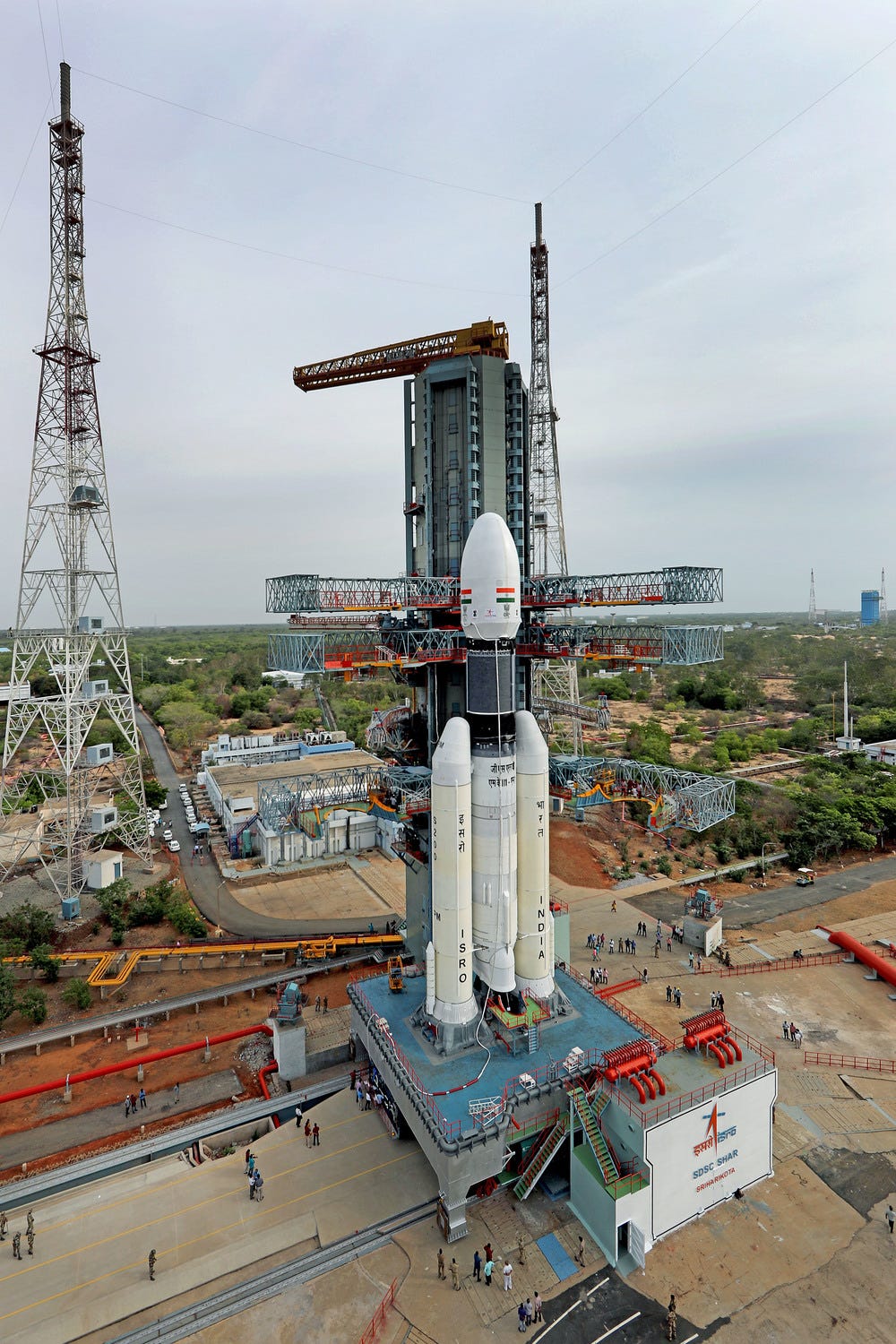
After lifting off at 2:43 pm on July 22, the rocket will place Chandrayaan 2 in a highly elliptical orbit around Earth. The total mass of the system—3,877 kg—falls just within the limit of what India’s most powerful rocket can handle. Once in the elliptical orbit, the orbiter’s engines will fire and perform multiple orbit-raising maneuvers until it takes the craft within the Moon’s gravitational influence. All this while, the orbiter will ensure its solar panels face the Sun to remain powered.
It’s interesting to compare this mission profile to one launched on a SpaceX Falcon 9 rocket, which costs about the same as the GSLV Mk III. The Falcon 9 can inject the same spacecraft directly into an orbit that goes all the way to the Moon, saving mission time and launch cost. This is something to think about instead of bragging about our cheap launch costs.
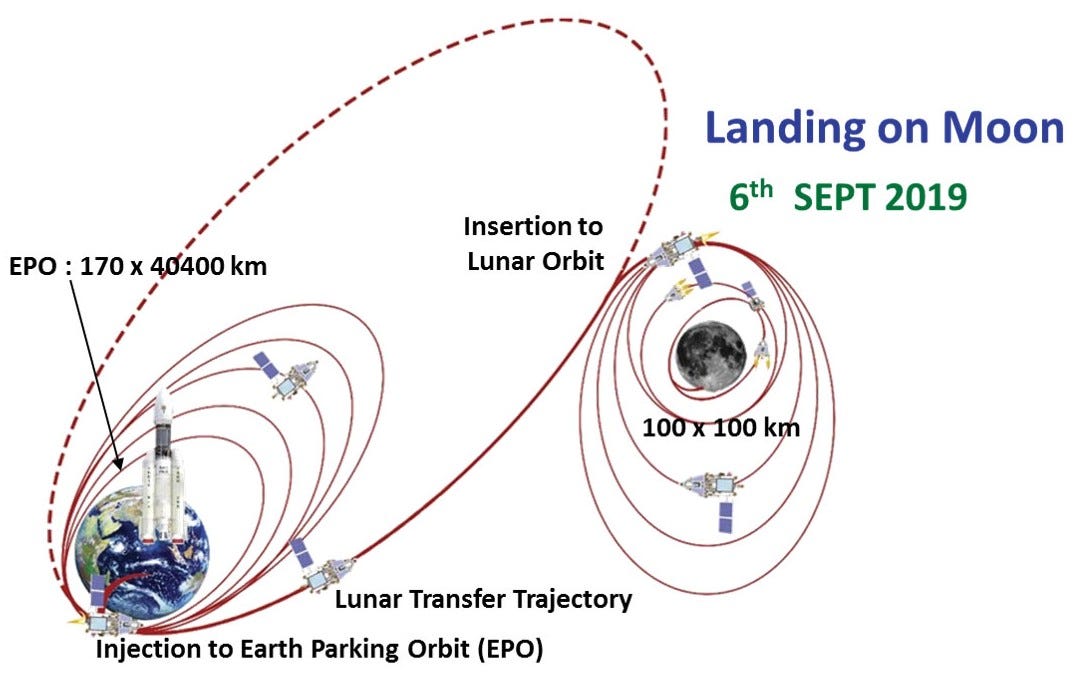
Approaching the Moon
Once Chandrayaan 2 is within the Moon’s gravitational influence, and getting closer, the orbiter will fire its engines in a direction opposite to its motion—like applying the brakes. This maneuver is necessary to ensure the craft allows the Moon to capture it. Chandrayaan 2 will now be in an elliptical orbit around the Moon. The closest point of the orbit is 100 km from the lunar surface and the farthest point will be several thousand kilometers away.
The craft will fire its engines several times again to lower its orbit until the orbit becomes circular (100 x 100 km). At this point, the lander, Vikram, will detach itself from the orbiter and enter a closer, elliptical orbit by performing a similar orbit-lowering burn. The advantage with a circular orbit is that it allows the orbiter to target the landing site in a more fuel-efficient way.
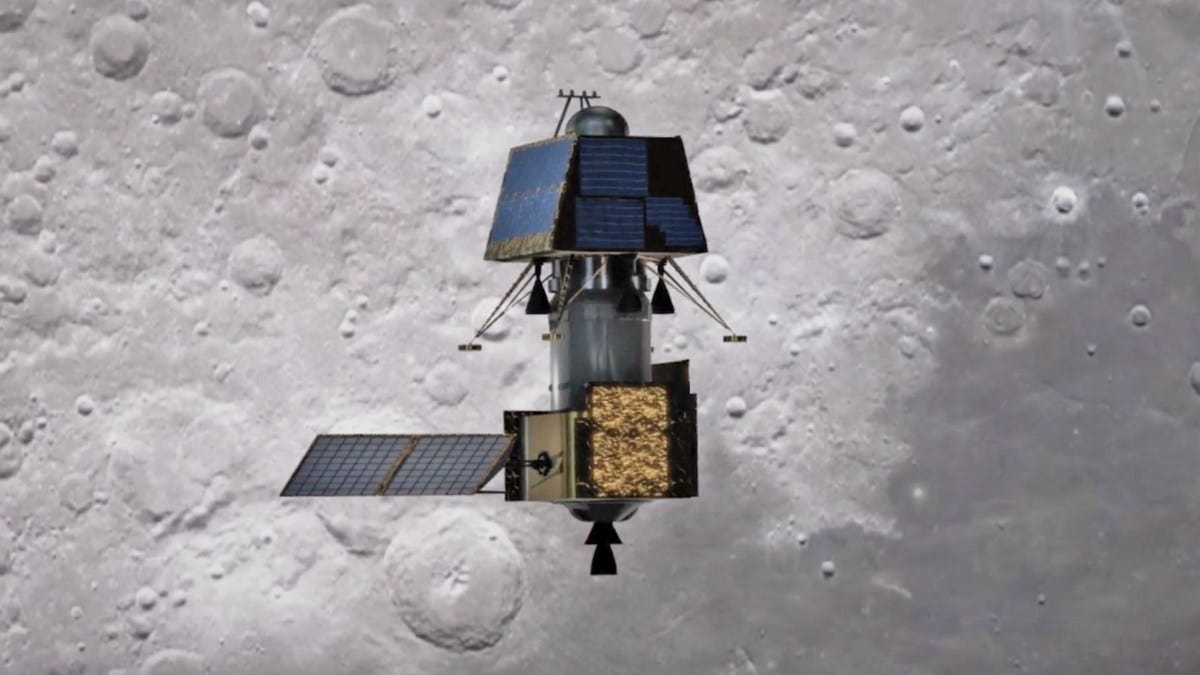
The orbiter’s high-resolution camera (OHRC) can photograph the Moon’s surface at a best resolution of 0.25 meters/pixel, which is better than the NASA Lunar Reconnaissance Orbiter’s (LRO) best resolution of 0.5 meters/pixel. The OHRC will be used to identify safe touchdown spots in the landing region.
Once it has, the lander will commence descent to the surface from the lowest point in its orbit. The nature of the last orbit is such that the lander will touch down after local dawn at the landing site. This maximizes the mission lifetime to an entire lunar day, from sunrise to sunset (14 Earth days), for surface operations. Both the lander and rover are solar-powered, and are designed to operate for 14 Earth days only.
Landing site
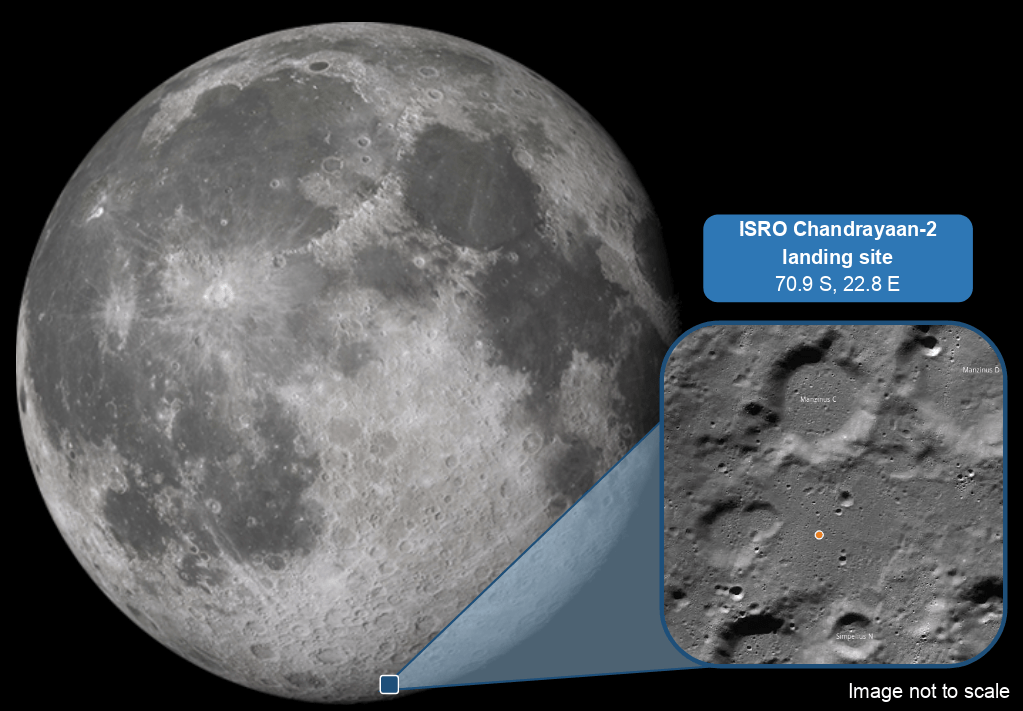
The Chandrayaan 2 landing site is in the Moon’s southern hemisphere, at 70.9° S, 22.8° E, in the highland (rocky) plain between the Manzinus C and Simpelius N craters. ISRO analyzed imagery and topography data from the LRO and the Japanese Kaguya orbiter to select the site. Only the Apollo 16 and the Surveyor 7 missions have landed in highland regions thus far; all others have descended in the dark, smoother lava plains.
Aside: ISRO has been touting Chandrayaan 2 as a south pole landing mission. This is technically incorrect. Conditions unique to polar areas, including eternally dark regions and long periods of sunlight, are prominent from the 80° S/N latitude onward, not from around 70° S/N. So ISRO’s claim of Chandrayaan 2 being the first mission to land in a polar region is wrong. Having said that, Chandrayaan 2 is landing closer to the lunar pole than any mission thus far.
Autonomous lunar descent
The lunar descent is the most intriguing and challenging part of the mission. First, all five 800 N engines on the Vikram lander will fire in tandem to decelerate the craft. They will keep firing until the craft is just a few meters above the lunar surface and has segued into a slow, steady approach.
Once the lander is right above the pre-identified safe spot, the engines will be cut-off and the lander will fall freely under the Moon’s gravity. The lander’s structural frame has been designed to take the load of the impact, with the landing legs absorbing most of the shock. The primary reason to cut the engines off before touchdown is to keep its exhaust plumes from kicking up dust from the surface and creating a backflow of exhaust gases, which can degrade critical spacecraft parts like solar panels, sensors, etc. and contaminate scientific instruments.
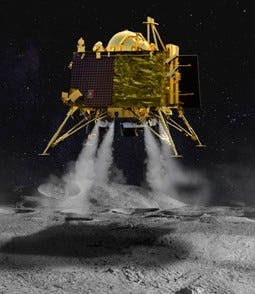
The entire descent stage is fully autonomous. During this stage, signals will take about three seconds to go from Earth to the lander and then come back. This is a significant delay in the scheme of things, so it won’t be practical for ISRO engineers on Earth to guide the landing. Instead, the lander has been equipped with sufficient intelligence to operate autonomously during the entire descent phase. This involves the onboard computer taking continuous input from sensors about its distance, velocity, acceleration, orientation, etc., computing its trajectory and auto-correcting it by orchestrating firing of the engines, until a safe touchdown.
If all goes to plan, Vikram will land on September 7.
The complexity and cost of such a robotic mission is enormous; so far, only three countries have been successful: the American Surveyor landers (1966–1968), the Soviet Luna landers (1966–1976) and the Chinese Chang’e landers (2013 onward). A recent landing attempt by an Israeli group failed.
The Mission
Once it has touched down, Vikram will recharge itself using the solar panels and establish a direct high-bandwidth communication link to Earth. It can also talk to the orbiter whenever the latter is in range. Once ISRO engineers have performed various health checks, the surface operations will begin.
The Pragyan rover will be deployed from the lander using a ramp. The rover will have no direct communication access to Earth or to the orbiter. It will communicate to the lander, which will relay the data to Earth. The comm-link between the lander and the rover has a maximum range of 500 m, which means Pragyan can’t go farther than this from Vikram or it will lose contact.
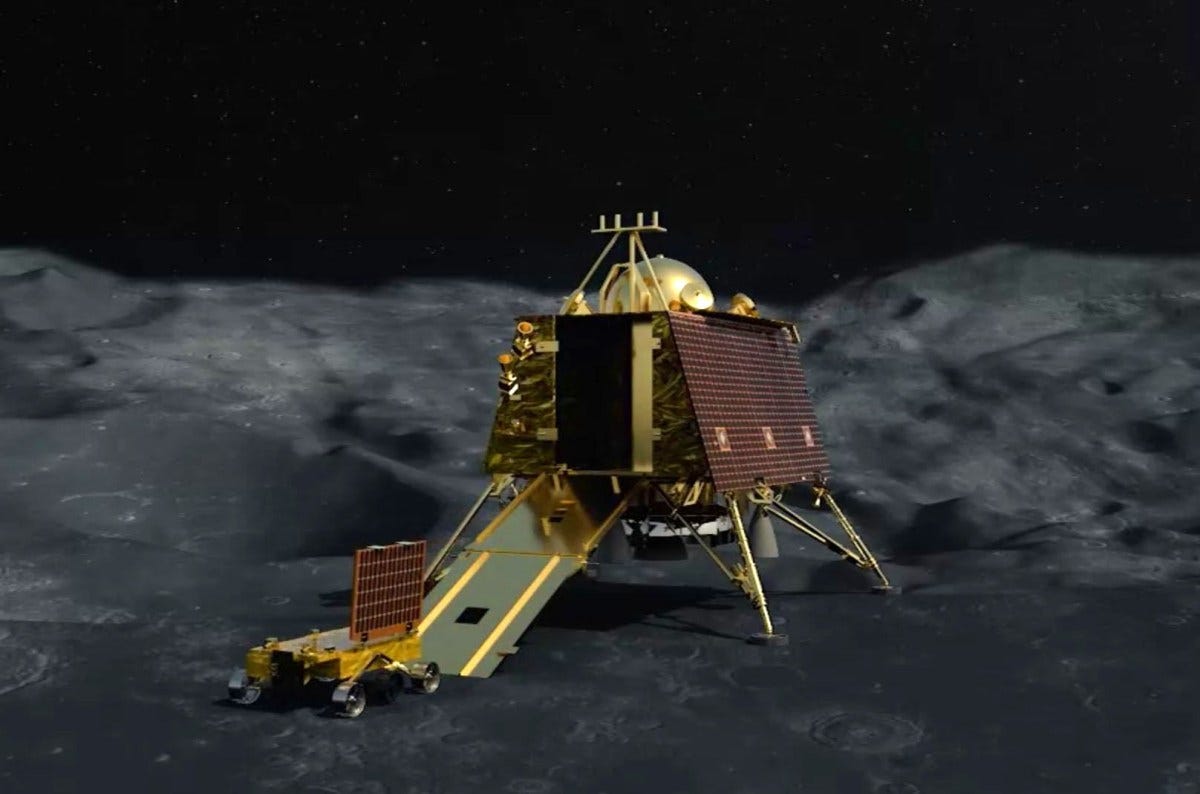
The solar panels on both the Chandrayaan 2 lander and rover are mounted nearly 90° relative to the lunar surface. Since the landing site is at ~71° S, the Sun won’t rise higher than ~19° in the sky. As a result, the sideways-facing solar panels are directly pointed at the Sun, maximizing power generation.
The orbiter, lander and rover, which together make up Chandrayaan 2, have their own sets of instruments. The orbiter carries eight while the lander and the rover carry four and two instruments respectively.
Surface science with Vikram
Vikram will insert a probe about 10 cm into the lunar soil to measure its thermal properties. A seismometer onboard will detect moonquakes, like NASA’s Apollo missions did. If a moonquake strong enough occurs during the mission, it could provide additional clues about what the Moon’s interior is like, particularly the core. Vikram will also carry a Langmuir probe to determine the amount, distribution and properties of hot, ionized particles on the lunar surface created by the solar wind, and a radio occultation experiment that will measure electron density in the Moon’s thin but persistent atmosphere.
NASA has contributed a laser retroreflector, much like they did to the Israeli mission that failed. Scientists will bounce laser pulses off the laser to understand the gravitational dynamics of the Earth-Moon system better.
Lunar geology with Pragyan

The six-wheeled rover Pragyan will study the geology of the landing region. A small-sized Alpha Particle X-ray Spectrometer, or APXS, will study what the rocks and lunar soil are made of. Both China’s Yutu rovers as well as all NASA’s Martian rovers have carried a similar instrument.
Pragyan also boasts of an ability that NASA’s Curiosity rover possesses: to shoot high-power laser pulses at a target material, vaporize it and analyze the emitted radiation to determine the material’s composition using a (different) spectrometer. The area where Vikram will land and which Pragyan will explore is geologically old, having formed at least 3.8 billion years ago. Both of Pragyan’s spectrometers are expected to find pristine materials from the ancient lunar crust, something no other mission has discovered before from this time period (3.8–3.9 billion years ago).
Mapping the Moon with the orbiter

Much like how LRO ‘saw’ Chang’e 4, it is expected that the Chandrayaan 2 orbiter will be able to capture images of Vikram and Pragyan from its orbit around the Moon. The orbiter will also continue to observe the Moon for one year, using — among other instruments — an advanced version of the mapping camera on Chandrayaan 1. Called the Terrain Mapping Camera 2, it will photograph large areas at a resolution of 5 m/pixel and generate 3D maps, comparable to LRO’s standard resolution. The aforementioned higher resolution camera will be used for specific areas of interest. Another instrument, called the Large Area Soft X-ray Spectrometer, will add mineral composition data to the maps.
One of the instruments that allowed Chandrayaan 1 to discover water ice on the lunar poles received an upgrade for Chandrayaan 2. The new Synthetic Aperture Radar (SAR) will map and quantify the amount of water ice at a higher resolution than the first and at better depths. SAR’s ability to penetrate deeper will also help scientists understand how the uppermost part of the lunar soil — called the regolith — is spread around the Moon. The orbiter will also use an infrared spectrometer to map the distribution of volatile substances, including those containing water and hydroxyl ions in and around the lunar poles, concentrated in permanently shadowed regions.
In all, the orbiter is going to be a versatile mapper, in many ways better than the LRO, which is now a decade old. Given that MOM will have been operating for five years this September, despite the nominal mission life being six months, ISRO believes the Chandrayaan 2 orbiter could survive for more than a year. However, let’s not forget that Chandrayaan 1 had a design life of two years but failed after only 10 months.
Is this enough?
The Chandrayaan 2 mission is a great technology demonstrator but is most limited by its lifetime. Having orbiters survive for longer is not as big a deal because they have easier access to sunlight compared to landed elements. However, it will be interesting to see if the LRO outlives the younger Chandrayaan 2 even after having been around for a decade.
That said, the true value of missions like Chandrayaan 2 banks more on the landed elements, which face more challenging conditions.
Both Vikram and Pragyan are designed to operate only for 14 Earth days. The problem isn’t that the lunar daytime is really hot but that the nights are too cold. Temperatures like -180º C aren’t unheard of. So once the lunar night kicks in, scientists expect both the lander and the rover will stop functioning and likely won’t awaken the next lunar morning. This in turn limits the mission’s scientific output.
It may not be fair to compare Chandrayaan 2 to NASA missions, past or present, but it would certainly be fair to compare them to their Chinese counterparts. China’s first lunar lander, Chang’e 3, touched down successfully in 2013 and is alive to this day. It uses radioactive heater units to survive the lunar night. More notably, the lander has been actively powering an ultraviolet telescope, one of the only two operational extraterrestrial telescopes in existence. The second such telescope also belongs to China, onboard Chang’e 4, the world’s first mission to land on the Moon’s far side. Its lander and rover both survive the lunar night fine and the mission is already six months in, continuing to relay troves of data.

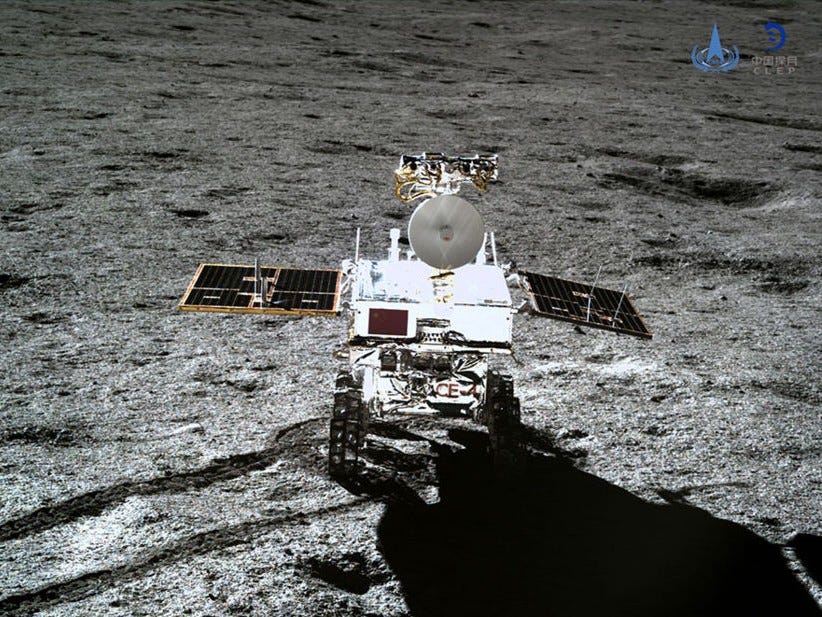
Another worrisome aspect is that, save for NASA’s retroreflector, ISRO didn’t solicit international payloads for Chandrayaan 2. International payloads onboard Chandrayaan 1 were responsible for discovering water on the lunar poles. This is not to say that Indian science experiments aren’t capable but that global collaboration is likely to yield better results for everyone. India didn’t solicit international payloads for its Mars orbiter Mangalyaan either. It’s not a good strategy to do everything on one’s own, including a space station. South Korea, for example, is partnering with NASA for their first lunar orbiter in 2020.
The price-tag argument would simply be beating around the bush. Further, and again unlike its eminently comparable Chinese counterparts, ISRO’s forays into space seem to be composed of isolated missions not strung together by an overarching program. It’s not about if Chang’e 3 or 4 are superior but about the roadmap that drives the Chinese lunar program, which is a program. The roadmap’s next endeavor is a sample return mission this year, Chang’e 5, a significant jump in complexity over Chang’e 4.
On the other hand, what is it that we hope to do after landing on the Moon? How does the technology feed forward in an effective way to solve fundamental problems in space exploration? If we’re going to compete with China in our little space race, we might as well take cues from their roadmap and build one for ourselves.
Originally published at The Wire.
Thanks to Adithya Kothandhapani for reviewing the article.
→ Browse the Blog | About | Donate ♡
